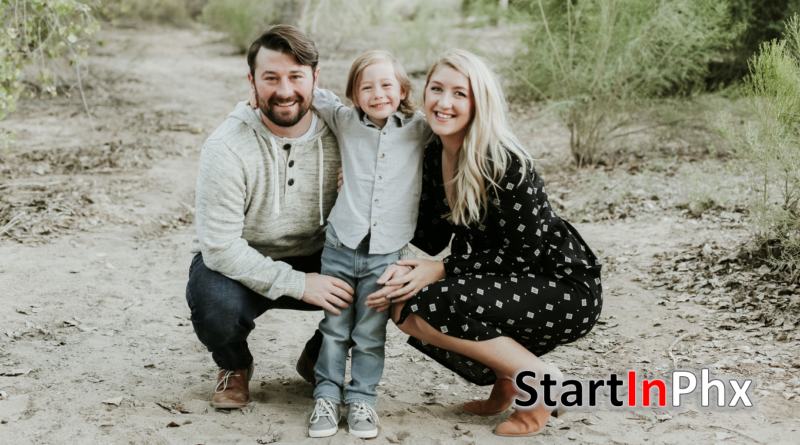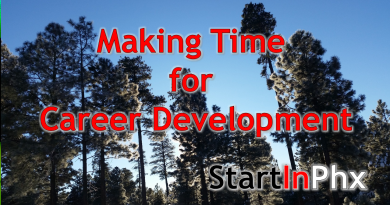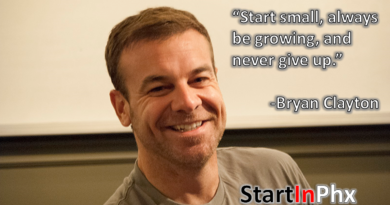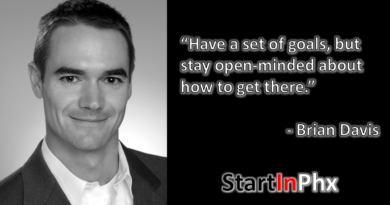10 Business Leaders Share Their Best Sales & Marketing Advice
10 Phoenix Business Leaders
Share Their Best Advice On
Sales & Marketing
1. Not Every Suspect is a Prospect
Matthew Owens || Co-Founder of OH Partners
(Phoenix, AZ)
When selling services that will require many months or years to deliver, there needs to exist a compatibility between provider and buyer.
This doesn’t just mean that the buyer needs to be able to afford the provider’s rates, but that they have a need the provider can realistically meet at that point in time. There also needs to be a cultural compatibility between the individuals and organizations involved. This ensures they can play well with each other.
Without these things dysfunction is imminent. Bringing with it broken promises, hurt feelings, lost investments, and missed revenue. Knowing this, Matt and his team aren’t afraid to turn business away if compatibility on price, needs/capabilities, and culture don’t exist.
Because of this the OH Partners’ sales process is one that prospects can be disqualified from quickly. At OH an initial meeting to simply measure cultural-fit between the two organizations is standard. That way OH executives know whether it’s worth the time and energy of their creative and technical staff to work up ideas worth pitching to the prospective client.
2. Internal Marketing Will Make You More Money Than Marketing to Buyers
Justin Gray || Founder & CEO of LeadMD
(Scottsdale, AZ)
Educating your team on how sales and marketing works, how to capture data, and how to use data is the only way to stay on top of buyer journeys throughout the growth and personnel changes that will inevitably take place in your company.
And yes – YOU will have to teach your people these things, because there are very few who already have this knowledge that can be hired off the street. The fact is that a significant skills gap plagues the sales and marketing labor pool.
While there are incredibly powerful tools that allow skilled marketing and sales professionals to do great things and provide phenomenal buyer experiences, at the rate in which these technologies evolve the educational institutions can’t keep pace.
In short, there is a talent shortage.
Knowing this Justin and his team at LeadMD are leading the charge to overcome the talent shortage through an internal initiative and hiring accelerator they call Marketemy. In this program students are paid to learn how and why to use the industry’s leading technologies through computer based simulations and actual client work.
And on a larger scale LeadMD has productized the Marketemy curriculum through their experience-based learning platform Six Bricks.
3. Your Pitch Sucks, Do This Instead to Get More Sales
Gelie Akheblit || Founder of NetworkingPhoenix.com
(Phoenix, AZ)
The truth is that human beings are self-obsessed.
So while you may think everyone should be just as excited as you about the thing you do or sell, the rest of society is consumed with trying to get you excited about the things they do or sell.
So how do top-producers win over prospects, get people excited about their offers, and make sales?
They listen.
Rather than hitting every passing stranger with a pitch, they listen.
It is through leaning into conversations with questions that get a new prospect talking about what they are most excited or concerned about – and then listening to what is said – that top-producers find opportunities to sell.
Listening also does something else that is really useful for sellers.
It makes you interesting to the person doing the talking. When you listen and express interest in the things your prospect wants to talk about, they can’t help but become interested in you.
By listening you validate their emotions and that validation feels good. Most people want that good feeling to continue and so they instinctively return the favor of validation by inquiring about you and your life. Which is a perfect time to talk about the things that excite you (i.e the thing you sell).
Of course, at this point in a conversation – after all the listening you’ve done – you’ll likely know how qualified the prospect is to buy from you and exactly how to position your offer so that qualified prospects will want you talk about it in even greater detail.
So even with being self-diagnosed as “Terrible at sales,” Gelie Akheblit has built a very healthy career in selling her services as a consultant and selling NetworkingPassport® subscriptions on NetworkingPhoenix.com.
4. Without a CULT Your Business is Going Nowhere
Aram Chavez || Creator of Aha to Exit Map
(Chandler, AZ)
Your CULT or Customer User Lead Tester is a group of experts in the field you’re trying to serve.
In being experts they each have audiences that cling to their every word and live based on this expert’s recommendations.
Members of your CULT have built their careers and audiences by rejecting mediocrity. If your offer is garbage, they’ll let you know. But if you can impress them, they’ll tell everyone to buy from you.
When it comes to innovation speed is critical. You can’t wait too long to present your offer to your CULT or your competition will beat you to it, iterate faster, and steel the market-share you were hoping to have for yourself.
Your CULT will also be crucial to driving the evolution of your offer.
Yes, they will definitely cut you down if they are not wowed by your early versions. However, when you return again and again with improved versions of your product or service based on their feedback the members of your CULT are likely to start feeling invested in your success.
With this feeling of being invested in your success members of your CULT will take pleasure in sharing your offer with their masses once it’s perfected.
This is exactly what happened when Aram Chavez was part of Zicam’s launch. The nasal spray was first presented to pharmacists and iterated over and over again until pharmacists were excited to recommend the product to the customers who regularly sought and trusted their recommendations.
5. Real Revenue is Born on Social Media Every Day
Jack Kosakowski || CEO (US Division) at Creation Agency
(Scottsdale, AZ)
True best-practices in sales and sales strategies are evergreen.
If it worked via email, phone, and when you saw someone in-person, then there is probably a way to amplify your 1-to-1 approach for communicating with prospects via social media. Doing so would give you both the benefits of 1-to-1 communication and 1-to-many marketing simultaneously.
According Jack Kosakowski there are opportunities to leverage social media at every level of your sales process, from lead-gen, to nurturing, to closing new business.
Especially in B2B sales where sellers are not always granted access to the full committee weighing in on a buying decision, social media can provide a channel through which those silent or invisible committee members can be influenced.
6. Sales Team Success is Rooted in Common Objectives and Vocabulary
Kerstin Hadzik || Partner at NOW CFO
(Tempe, AZ)
NOW CFO relies on pairing the talents of their business development staff, these folks are typically earlier in their career, with the technical experience of veteran accounting staff to close new business as a team.
In many ways this partnership is a perfect balance, but at the same time the drastic difference in personality types and the typical generational divide that comprises these teams, can make working as a unit difficult.
To simplify their team-selling Kerstin and her team have gamified their business development activity with a point system. Different types of activity, like going to a networking event versus scheduling a meeting with a qualified sales lead, are assigned different point values.
This gamification keeps things light and fun, but also gives the team a shared set of objectives. Everyone knows what kind of activity gets the business closer to a new sale and what the order of priority is for those activities, because the highest priorities are worth the greatest amount of points.
The point system not only simplifies NOW CFO’s business development processes, but it simplifies their conversations about business development. The point system give this wide range of personalities, with different views of the world, a common vocabulary from which they can work together.
The best part about how NOW CFO gamifies their sales and marketing activity is that the simplicity means team members can get down to business and make improvements fast.
7. When You Do Sales and Marketing Right… 1+1=3
Sean McGraw || CEO at FOR Energy
(Tempe, AZ)
Even though marketers and business leaders like to get wrapped up in correlating dollars spent and revenue realized per tactic used, the truth is that it isn’t so cut-and-dry. When it comes to your marketing mix, its impact is always greater than the sum of its parts.
Sean McGraw sees this everyday through the sales and marketing wins of his company FOR Energy. In selling to homeowners his team does things like canvasing neighborhoods, knocking on doors and calling homeowners on the phone to make first contact.
To a lot of marketers these tactics seem dated and obsolete. Some would argue that the success rate of these tactics is too low to justify the expense.
The general population would like to think that it is the one-to-many marketing tactics that add leads to a company’s marketing funnel and push prospects toward conversations with salespeople. While this does happen, the truth is that it works the other way.
In a lot of cases it is our direct sales tactics that give prospects an association with our brands. This in turn helps our one-to-many branding tactics get noticed, which then reinforces messaging delivered by salespeople.
The buyer’s journey isn’t linear. That’s why in the world of sales and marketing 1+1=3.
In the same way, when the phone and door-to-door tactics used by FOR Energy generate a sale in a new neighborhood, it’s just the first win in a long chain of ever growing revenue momentum.
From this initial sale a company vehicle is deployed, wrapped in the company’s branding. It’s hard to not notice these kinds of vehicles when they are parked outside of your neighbor’s house. You can bet they get seen by prospects who have already spoken to a door-to-door sales rep or at least saw the door-hanger that was left behind.
Some services provided by FOR Energy require subsequent visits to a customer’s home by technicians in these company vehicles. Each trip is an impression that builds social proof with onlookers, even the skeptics that turned down service when first contacted by FOR.
Similarly, the lawn sign that gets placed during a project or left behind after a project, along with subsequent knocks at the door and calls on the phone makes an impression. Each is an opportunity for the prospect to get to know, like, and trust the company a little bit more.
Each prospect has its own tipping point. After seeing the trucks and signs and speaking with their neighbors, some homeowners will want to know the experience people in other neighborhoods had working with FOR Energy. For this reason the company makes it a point to accumulate social proof in the form of online reviews on Google and elsewhere.
Of course, if this phone calling and door-knocking company had you thinking they were somehow stuck in the stone-age, they are also driving traffic through digital demand generation. Which is made more effective with the social proof acquired from offline tactics.
And it is through stacking marketing and sales tactics this way – new and old – that Sean and the FOR Energy Team have landed among the 5,000 fastest growing companies according to Inc.
8. Selling Never Stops, Not Even When You Have Cash in Hand
Ty Largo || Owner + Creative Director at AWE Collective
(Tempe, AZ)
Especially with creatives services like branding or advertising, clients sign-on knowing that they lack a skill or expertise to achieve the particular result they’re looking for.
And even though they know what got them where there are won’t get them to where they’d like to be, it’s not uncommon for clients to fall into the trap of security, defaulting to what they’ve always done. It’s just more comfortable to do so. Change is scary.
Of course, this kind of comfort-zone trap can be found in every vertical of consulting from engineering to design and even in financial services.
Even though the client has paid money for an expert opinion it inevitably falls on the expert to continually sell their client on the suggestions and opinions they provide.
Otherwise, the client might simply default to what’s comfortable, rather than do what’s uncomfortable but provides the desired result they seek.
How does Ty Largo keep his clients from falling into the comfort-zone trap?
Using some of the same devices many of us use in closing new business, upfront verbal contracts and refusing to conduct one-legger meetings.
9. Truly Qualified Prospects Can EASILY Afford You
Ken Bonham || Partner at Lucid Agency
(Tempe, AZ)
In a world where there is no prize for being the 2nd lowest priced provider, you want to charge a fair (but preferably premium) rate for the solutions you provide.
However, if your service or solution is going to break the bank before you can deliver the desired result you’ll never reach your destination.
That’s why Ken and his team at Lucid Agency firmly believe that the second law to their 6 Laws of Winnable Deals is that prospects can EASILY AFFORD their offer before trying to do business with them.
Lucid is in the business of providing performance based, digital marketing services. In doing so they charge their clients on a regular interval over the course of an engagement. That makes this very different from selling a luxury watch for example.
If the goal of buying a watch is to give confidence to the person who wears it, the goal is achieved as soon as the purchase is made and the watch goes on the buyer’s wrist.
The buyer is also not required to pay for that feeling over and over again, they now own it. So even if the initial purchase is a bit of stretch, it probably won’t impact the buyer’s ability to pay for other things over the next few months.
In a B2B transaction like that of marketing services, where the desired results can’t always be realized as instantaneously as purchasing a luxury watch, pricing that causes the buyer to feel stretched financially can make reaching the desired result impossible.
Why?
Because the likely outcome is that the client will pull the rip cord on services and stop making payments before any meaningful work can be achieved.
So before get yourself into such a bind, heed the lesson we learned from Matt Owens above, “Not every suspect is a prospect.”
If the potential buyer can’t afford your offer EASILY it’s more likely that this will end in broken promises, hurt feelings, lost investments, and missed revenue rather than success.
If the prospect can’t afford your offer they are better defined as a suspect than a prospect.
10. Paying Commissions on Sales Isn’t as Motivating as You Thought
Cindy Eager || Founder and President at Partner Up
(Queen Creek, AZ)
When Cindy Eager got started in affiliate and partnership programs at Infusionsoft she learned that money alone didn’t do much to entice marketing agencies and consultants to sell their Saas product consistently.
To Cindy, “Commissions are really just table stakes.” In order to get referral partners to send you new business month over month, your offer has to bring revenue into their company directly and indirectly.
For companies trying to increase revenue through the addition of channel, partner, or affiliate sales this means a few things.
First, you’ll have to demonstrate demand for the offering you want partners to sell for you. No smart business owner is going to take on the challenge of generating demand for something that isn’t a proven seller. It’s not a safe bet for the resources they’d have to invest.
For this reason a channel, partner, or affiliate program might not be the place to start for a new company. You’ll need to sell your thing before anyone else is going to attempt to sell it for you.
Second, you’ll have to support your partners continuously through training and enablement. That means you’ll probably have to assign staff to the effort of growing revenue through your partner program.
What this really means is that commission-only partnerships are not an inexpensive way to grow revenue.
Affiliate and partner programs work as a way to grow revenue. They work especially well when done right. But just like any form of marketing there is an investment of time, energy, and money that will be required in order to make the initiative successful.
Want More Sales?
This could be your year!
All you need is a fail-proof way of getting MORE MEETINGS and closing MORE SALES.
You know your business and I KNOW SALES.
So what are you waiting for?
Schedule a time for us to connect by phone and identify 3-5 ways for you to get MORE MEETINGS and close MORE SALES in the next 90-days.
Click Here to Schedule
Your Free Phone Consultation






Great way to recap and repurpose your existing content Brendan 🙂 Nice takeaways for sure.
Thanks Justin! When are we going to get you on the show? 😉
Great information except not ever suspect is a prospect. It depends on the industry. I was in generator sales and preventative maintenance agreements as well as repairs. Also in water treatment of boilers and chillers. I new were my potential customers were and who had the products and services needed. On the east coast I was none as a top sales producer.
Hey Samuel – If you have enough insight to know that a particular person or organization has a legitimate need for you product or service are they still a suspect?
Or have you in fact qualified them as a prospect? 🙂